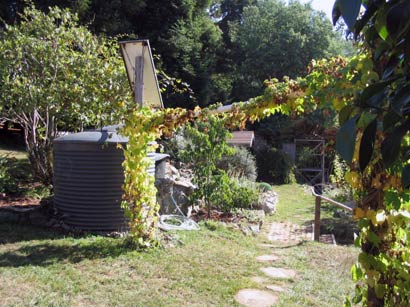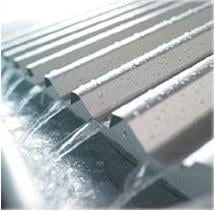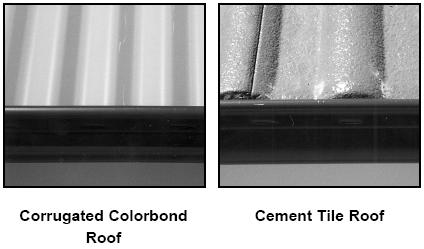Background

Humboldt State University's Campus Center for Appropriate Technology (CCAT) was started in 1978 and has been going strong since. With three live in students per year, and 18 student employees, CCAT is a “live in demonstration home” where the students of Humboldt State University and the local community actively partake in creating and maintaining a home in a sustainable way, by incorporating many aspects of Appropriate Technology.
CCAT is in need of a reinstallation of their rainwater catchment system. A system had been installed at the original Buck house, but due to construction and relocation, it was dismantled. With many supplies ready for reuse, and the advantage of hindsight, it is now time to reinstall an efficient and aesthetically pleasing rainwater catchment system.
What an Opportunity!
The ability to harvest enough rainwater for practical daily use in coastal Humboldt County is very realizable[verification needed]. This appropriate technology is an integral part of a sustainable home. With CCAT striving to be a live-in demonstration of a sustainable home, and being located in coastal Humboldt County, it is just waiting for the water flowing out of the downspout to be redirected into a storage tank.
Two students from Spring 2008 ENGR 305 will be assessing what supplies and structures are currently available at CCAT, such as gutters, pipes,and the all-important massive storage tank. The opportunity to learn about the application and installation of this type of system will be further spread to those who visit CCAT. There, people will be able to learn directly about how the system works through interpretive signs and other literature. As such, this project will benefit not only those who live in CCAT, but anyone who visits the demonstration home.
Criteria
Aesthetics - Because CCAT is a demonstration home, the system should look well built and maintained. It must also be have a non-intrusive design, and be out of the way.
Budget - Initial cost should be reasonable for this type of system. Even though CCAT has a budget for these types of student projects, they already have many of the necessary materials on site. As such, as many materials as possible will be reused. Furthermore all materials will be accounted for in the budget.
Restoration - The materials on site must be evaluated and restored. The existing gutter system needs cleaning and restoring, fixing all leaks and washing the system clean.
Durability - The system needs to be able to withstand the weight of the water in the storage tank when it is full, and the tank should be secured so it won't blow away when it is empty. Care must be taken to ensure the tank will be stable when it is full and empty.
Educational Value - The system must have some educational value. Again because of the CCAT house being an educational demonstration home, the system will have an education poster that explains the system as a whole.
Efficiency - The retained water needs to be easily accessible for daily irrigation use. The tank needs to be sited in such a way that creates the maximum amount of head to decrease the amount of pumping necessary to move the water uphill.
Functional Design - It has to work. The tank must not leak, everything must work and be able to be maintained. The tank must be accessible and out of the way. The filter system must work, and the overflow should be directed to a useful area..
Roofwasher/First flush System - There will be a functional roofwasher and/or first flush system installed to reject the first 10 gallons minutes? of a rainstorm, thereby keeping the tank free of dirt, dust, debris, and bugs.
Literature Review
Tank
The most expensive component of a rainwater catchment system is the storage tank[1]. Luckily, we are able to reuse the original tank that was donated to CCAT. It is made of grey corrugated polypropylene. As with any material, there are advantages and disadvantages:
Advantages or polypropylene
- Relatively inexpensive
- Lightweight
- Durable
- Long lasting
Disadvantages of polypropylene
- Must be installed above ground, as standard tanks cannot withstand soil expansion and contraction
- The plumbing fittings might leak[2]
The tank is 7ft tall with a diamiter of 5ft, cylindrical in shape. According to John Gould, cylindrical or spherical shaped tanks optimize the use of materials and increase the strength of the tank walls[3].
Roof
The potability of the harvested rainwater is dependent on many factors. The most obvious is the material of the catchment surface, or, in this case, the roof. CCAT's roof is made of asphalt shingles, which is not ideal for potable water usage due to leaching of chemicals[verification needed]. As such, the water collected with this catchment system will only be used for irrigation.
Due to the deteriorating condition of the current roof, CCAT is in the market for a new one. If an ideal rainwater catchment surface is selected for installation, this catchment system could be expanded to meet the needs of domestic water use.
Ideal Roof Materials
| Metal | Clay/Concrete Tile |
|---|---|
| The smoother the catchment surface, the better. Metal roofing materials, whether galvanized corrugated steel or aluminum, provide a smooth, bacteria un-friendly surface for rainwater to flow down. There are many options of various styles, alloys, and colors of metal roofing. Care should be taken on all re-roofing to not use lead flashings, as these will contaminate the water supply[4]. | These porous materials are suitable for both potable and nonpotable systems. Due to the porous nature of these materials, some choose to paint of coat the tiles with a sealant to reduce water loss and prevent bacterial growth. This sealant should be non-toxic[5]. |
 |
 |
Arcata, CA Average Percipitation
| January | Febury | March | April | May | June | July | August | September | October | November | December | Anual |
|---|---|---|---|---|---|---|---|---|---|---|---|---|
| 5.97 in. | 5.51 in. | 5.55 in. | 2.91 in. | 1.62 in. | 0.65 in. | 0.16 in. | 0.38 in. | 0.86 in. | 2.36 in. | 5.78 in. | 6.35 in. | 38.10 in. |
MSN Weather- Yearly, Monthly Temperature and Percipitation Averages and Records for Eureka, US: [1]
Roof Footprint
Calculating Container Volumes
Tentative Timeline
- March
Finalize design, acquire all materials, clean out gutters, patch any holes in gutters, coordinate with CCAT on all of the tiny details.
- April
Construct the concrete pad over a sunny weekend, install all plumbing and fixtures, Complete installation. Testing, testing. Write a report and finish this wiki.
- May
Fix any unforeseen problems, present our project to the class.
Design
Restoration
To start our project, we must restore what exists. What exists is the rain gutter, and that is about it. We are going to pressure wash the roof clearing it of any debris and dirt before we start. After the gutters have been checked for leaks and loose mounts, all problems will be corrected.
Tank
Then next part of the design is the tank. It is 7 feet tall, and 5 feet wide. This results in about xx,xxx gallons, witch ways about 8000lbs. We will need to excavate an area were the tank is to be placed. Then a 6ft x 6ft x 8in concrete pad will be poured that will support the tank. There will be an overflow 3” white PVC pipe on the south side of the tank, starting at the top, and leading to the existing French drain. The outtake will be located on the front of the tank (west side) with a 3” Gate valve connected to a reducer that allows for a hose bib to be connected. Finally the intake will be located on the north side of the tank witch will come directly from the First Water Catchment System.
First water Catchment System
The First water catchment system is simply a 10-gallon tank, mounted to plywood and the house, which is connected before the cistern. It will use a “Y” connector to take water from the main line into the system. At the bottom of the system is a cleanout for the removal of sediment, and finally at the very bottom is a hose bib draining into the French drain at a very slow rate.
Delivery System
The Delivery system is simple, a length of 3” PVC pipe directed from the Roof Washer to the First Water Catchment System. It has 2 quick connects at the top and bottom for maintenance and cleanout, and the entire length is mounted to a strip of plywood that is connected directly to the siding of the CCAT house.
Roof Washer
The roof washer is mounted to plywood, and is simply a screen that keeps larger debris out of the system. It is a conical shaped screen mounted inside the cup of an 8” PVC reducer to 3”. After the reducer are some connectors that then leads to the delivery system.
Budget
Slab
| ---Price--- | ---Item--- |
|---|---|
* XX.XX $ * XX.XX $ * XX.XX $ * XX.XX $ * XX.XX $ * 00.00 $ * 00.00 $ * XX.XX $ |
* 12' x 2" x 8" Form Boards @ X.XX $ / ft. * 25' 1/2" Rebar @ X.XX $ / ft. * 6' x 6' #10 4" x 4" wire mesh * 1 Yard Concrete delivered * Wooden Stakes (24" long) * Recycled Gravel/Sand (5-10 Gallons) * Recycled Vapor Barrier 6' x 6' x 3mil Plastic * Nuts, Screws, Washers, etc. |
* XX.XX $ |
* Total |
Tank
| ---Price--- | ---Item--- |
|---|---|
* 00.00 $ * XX.XX $ * XX.XX $ * XX.XX $ * XX.XX $ * XX.XX $ * XX.XX $ * XX.XX $ |
* Recycled Water Tank * 6 90^ 3" fittings @ X.XX $ / per * 3" Quick Connect * 3 3" connection to tank @ X.XX $ / per * 12' of 3" White PVC Pipe @ X.XX $ / ft. * 3" Bal valve * 3" slip to threaded connection * Nuts, Screws, Washers, etc. |
* XX.XX $ |
* Total |
First Water Catch
| ---Price--- | ---Item--- |
|---|---|
* XX.XX $ * XX.XX $ * XX.XX $ * XX.XX $ * XX.XX $ * XX.XX $ * XX.XX $ * XX.XX $ * XX.XX $ * XX.XX $ * XX.XX $ * XX.XX $ * XX.XX $ * XX.XX $ |
* 2' x 8' x 3/4" Plywood * 3" Quick Connect * 3" Y Connector * 1' of 3" White PVC pipe @ X.XX $ / ft. * 8' of 8" White PVC pipe @ X.XX $ / ft. * 8" y Connector * 8" Cleanout Adapter * 2 8" to 3" Reducer @ X.XX $ / per * 3" to 1" Reducer * 1" Hose Bib * 90^ 1" Fitting * 1" slip to 1" threaded * 8' of 1" sheetmetal strap @ X.XX $ / ft. * Nuts, Screws, Washers, etc. |
* XX.XX $ |
* Total |
Roof Washer
| ---Price--- | ---Item--- |
|---|---|
* 00.00 $ * XX.XX $ * XX.XX $ * XX.XX $ * XX.XX $ * XX.XX $ * XX.XX $ |
* 2' x 2' 3/4" Plywood * 3" Quick Connect * 2 90^ 3" Connect @ X.XX $ / per * 2' of 3" White PVC Pipe @ X.XX $ / ft. * 2' of 1" sheetmetal strap @ X.XX $ / ft. * 8" to 3" adapter * Nuts, Screws, Washers, etc. |
* XX.XX $ |
* Total |
Restoration
| ---Price--- | ---Item--- |
|---|---|
* 11.98 $ * 02.99 $ * 25.00 $ * 00.00 $ |
* 2 tubes Aluminum/Metal Silicone @ 5.99 $ / per * Palm Scrub Brush * 1/2 Day Pressure Washer Rental * Nuts, Screws, Washers, etc. |
* 38.97 $ |
* Total |
Distribution
| ---Price--- | ---Item--- |
|---|---|
* XX.XX $ * XX.XX $ * XX.XX $ * XX.XX $ |
* X' of 3" White PVC Pipe @ X.XX $ / ft. * 3' of 1" sheet metal Strap @ X.XX $ / ft. * 4" x 6' x 3/4" Plywood Strips * Nuts, Screws, Washers, etc. |
* XX.XX $ |
* Total |